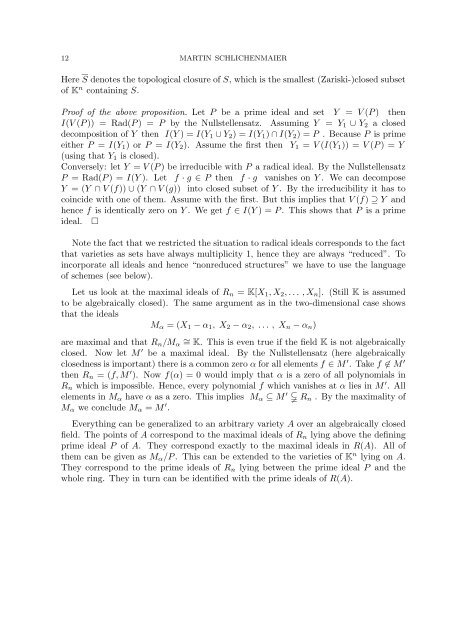Mannheimer Manuskripte 177 gk-mp-9403/3 SOME CONCEPTS OF ...
Mannheimer Manuskripte 177 gk-mp-9403/3 SOME CONCEPTS OF ...
Mannheimer Manuskripte 177 gk-mp-9403/3 SOME CONCEPTS OF ...
- No tags were found...
You also want an ePaper? Increase the reach of your titles
YUMPU automatically turns print PDFs into web optimized ePapers that Google loves.
12 MARTIN SCHLICHENMAIERHere S denotes the topological closure of S, which is the smallest (Zariski-)closed subsetof K n containing S.Proof of the above proposition. Let P be a prime ideal and set Y = V (P) thenI(V (P)) = Rad(P) = P by the Nullstellensatz. Assuming Y = Y 1 ∪ Y 2 a closeddeco<strong>mp</strong>osition of Y then I(Y ) = I(Y 1 ∪ Y 2 ) = I(Y 1 ) ∩ I(Y 2 ) = P . Because P is primeeither P = I(Y 1 ) or P = I(Y 2 ). Assume the first then Y 1 = V (I(Y 1 )) = V (P) = Y(using that Y 1 is closed).Conversely: let Y = V (P) be irreducible with P a radical ideal. By the NullstellensatzP = Rad(P) = I(Y ). Let f · g ∈ P then f · g vanishes on Y . We can deco<strong>mp</strong>oseY = (Y ∩ V (f)) ∪ (Y ∩ V (g)) into closed subset of Y . By the irreducibility it has tocoincide with one of them. Assume with the first. But this i<strong>mp</strong>lies that V (f) ⊇ Y andhence f is identically zero on Y . We get f ∈ I(Y ) = P. This shows that P is a primeideal. □Note the fact that we restricted the situation to radical ideals corresponds to the factthat varieties as sets have always multiplicity 1, hence they are always “reduced”. Toincorporate all ideals and hence “nonreduced structures” we have to use the languageof schemes (see below).Let us look at the maximal ideals of R n = K[X 1 ,X 2 ,... ,X n ]. (Still K is assumedto be algebraically closed). The same argument as in the two-dimensional case showsthat the idealsM α = (X 1 − α 1 , X 2 − α 2 , ... , X n − α n )are maximal and that R n /M α∼ = K. This is even true if the field K is not algebraicallyclosed. Now let M ′ be a maximal ideal. By the Nullstellensatz (here algebraicallyclosedness is i<strong>mp</strong>ortant) there is a common zero α for all elements f ∈ M ′ . Take f ∉ M ′then R n = (f,M ′ ). Now f(α) = 0 would i<strong>mp</strong>ly that α is a zero of all polynomials inR n which is i<strong>mp</strong>ossible. Hence, every polynomial f which vanishes at α lies in M ′ . Allelements in M α have α as a zero. This i<strong>mp</strong>lies M α ⊆ M ′ R n . By the maximality ofM α we conclude M α = M ′ .Everything can be generalized to an arbitrary variety A over an algebraically closedfield. The points of A correspond to the maximal ideals of R n lying above the definingprime ideal P of A. They correspond exactly to the maximal ideals in R(A). All ofthem can be given as M α /P. This can be extended to the varieties of K n lying on A.They correspond to the prime ideals of R n lying between the prime ideal P and thewhole ring. They in turn can be identified with the prime ideals of R(A).
















